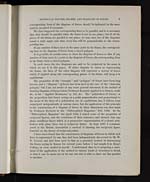James Clerk Maxwell (1831-1879)
On reciprocal figures, frames and diagrams of forces
RECIPROCAL FIGURES, FRAMES, AND DIAGRAMS OF FORCES.
3
corresponding lines of the diagram of forces should be indicated by the same
symbol, accented if necessary.
We have supposed the corresponding lines to be parallel, and it is necessary
that they should be parallel when the frame is not in one plane; but if all the
pieces of the frame are parallel to one plane, we may turn one of the diagrams
round a right angle, and then every line will be perpendicular to the corres-
ponding line.
If any number of lines meet at the same point in the frame, the correspond-
ing lines in the diagram of forces form a closed polygon.
It is possible, in certain cases, to draw the diagram of forces so that if any
number of lines meet in a point in the diagram of forces, the corresponding lines
in the frame form a closed polygon.
In such cases, the two diagrams are said to be reciprocal in the sense in
which we use it in this paper. If either diagram be taken as representing
the frame, the lines of the other diagram will represent a system of forces
which, if applied along the corresponding pieces of the frame, will keep it in
equilibrium.
The properties of the “triangle” and “polygon” of forces have been long
known, and a “diagram” of forces has been used in the case of the “funicular
polygon,” but I am not aware of any more general statement of the method of
drawing diagrams of forces before Professor RANKINE applied it to frames, roofs,
&c., in his “Applied Mechanics,” p. 137, &c. The “polyhedron of forces,” or
the proposition that forces acting on a point perpendicular and proportional to
the areas of the faces of a polyhedron are in equilibrium, has, I believe, been
enunciated independently at various times, but the application of this principle
to the construction of a diagram of forces in three dimensions was first made
by Professor RANKINE in the “Philosophical Magazine,” Feb. 1864. In the
“Philosophical Magazine” for April 1864, I stated some of the properties of
reciprocal figures, and the conditions of their existence, and showed that any
plane rectilinear figure which is a perspective representation of a closed poly-
hedron with plane faces has a reciprocal figure. In Sept. 1867, I communi-
cated to the British Association a method of drawing the reciprocal figure,
founded on the theory of reciprocal polars.
I have since found that the construction of diagrams of forces in which each
force is represented by one line, had been independently discovered by Mr W.
P. TAYLOR, and had been used by him as a practical method of determining
the forces acting in frames for several years before I had taught it in King's
College, or even studied it myself. I understand that he is preparing a state-
ment of the application of the method to various kinds of structures in detail,
so that it can be made use of by any one who is able to draw one line parallel
to another.


